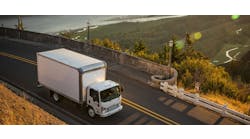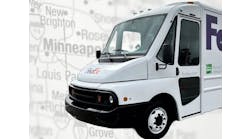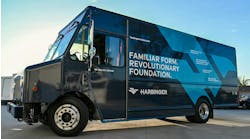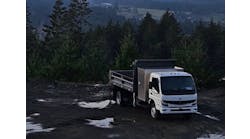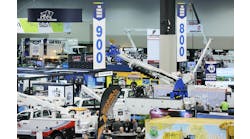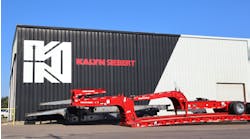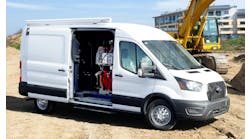Nearly five years ago, Kenworth began a research and development journey to revamp its 30-year-old medium-duty product line. After years of testing and insights from more than 500 fleet customers and drivers, the result is an all-new medium-duty (MD) truck line built from the ground up.
During an April 5 virtual unveiling, Kenworth officially introduced its new MD conventional truck lineup ranging from Class 5 to light Class 8. The new models, the Kenworth T180 (Class 5), Kenworth T280 (Class 6), Kenworth T380 (Class 7), and Kenworth T480 (light Class 8), are designed to serve a variety of applications including cargo and reefer van, beverage, tow and recovery, utility and government, fuel oil and propane, landscaping, fire, water tank, and dump and mixer. In addition, for fleets needing front-engine power takeoff (FEPTO), full parent rails and fixed grille, Kenworth added both the T380V and T480V with a vocational hood.
Production for the new line is expected to ramp up in the beginning of Q3 2021. Kenworth will eventually begin phasing out its legacy MD line, though that date is not set. However, Kenworth reps ultimately believe that once the new vehicles are out, a more natural replacement process will occur.
“The history of our medium-duty product across our whole manufacturing line was really a design down from Class 8,” Kevin Baney, Kenworth general manager and Paccar vice president, told an Endeavor CV Group editor during an April 1 media ride-and-drive event in Phoenix. “Every year we have [fleet] customer councils, and we meet with the councils to make sure we are still meeting their needs.”
Historically, it’s the fleet owner who makes the truck-buying decisions, but for medium duty, Baney said Kenworth reached out to a lot more people and spent the first year of development with even more customers and drivers.
“Medium duty is different because it’s more about the drivers,” he explained. “For the person who drives the landscape truck [T180 stake bed], for instance, driving is not their primary business. Their primary business is in landscape or other things. That truck is a means to an end.”
“The person who buys that mixer [T480] is so much different than the person who buys the stake bed or the van body truck [T280], so we had to touch enough drivers in each one of those different markets to truly understand what their needs were,” Baney added. “But the biggest thing is we knew we had to redesign the cab. The number-one feedback is that in most of these applications, they need three people in the cab because the truck is going to do a job that is not just delivering goods from point A to point B. We also wanted to get the cab lower on the chassis because we needed better ingress and egress.”
During the first year of the customer input phase, Baney said Kenworth purchased competitor trucks and held events with drivers. Kenworth lined up all the trucks and asked drivers what they liked, didn't like, and if there was something missing in the market. Then, Kenworth handed off that information to its engineering team, so the team could begin the design process.
However, when COVID-19 pandemic hit, it was a challenge because Kenworth couldn’t get its teams into Canada, where the installation work was happening.
“Half the process is revamping the entire manufacturing plant because it’s a new assembly process with all new materials,” Baney noted. “We are in the process of transitioning the current medium duty down and the new medium duty up, so that’s a ton of work in Canada right now. During COVID, we had to get special government permission to get our engineers in, and they had to quarantine. That was probably the biggest challenge with this program last year—just making sure that we were doing all the things on the manufacturing side.”
Truck spec details
After overcoming all the hurdles over the past year, now, Kenworth’s new lineup can be specified with either a standard low roof of 63 in. or a raised roof option of 67 in. The new trucks offer three hood types—short aero hood (107.5-in. bumper to back of cab, or BBC) that accommodates front axles from 8,000 to 20,000 lbs., medium aero hood (109.5-in. BBC) for higher horsepower and all-wheel drive (AWD) applications, and a vocational “sloped” hood for the T380V and T480V models. The shorter wheelbases produce a tighter turning radius and better maneuverability for urban or vocational operating environments.
A standard stamped steel low-profile roof that is 4 in. lower than Kenworth’s optional raised roof was developed for applications where cranes, pumpers or booms are used.
The new vehicles are available with the model year 2021 Paccar PX-7 engine rated up to 325 hp. and 2021 Paccar PX-9 engine up to 380 hp., depending on BBC. For the first time in its MD trucks, Kenworth will also offer the Cummins Westport L9N natural gas engine, which delivers 320 hp.
The new Paccar TX-8 automatic transmission is also standard for the Kenworth T180, T280, T380, and T480 models.
“The fuel economy piece has really seen an impact with the 8-speed transmission for the 280 and 380 models, primarily, because those models are where customers are more concerned about fuel economy,” Mike Kleespies, Kenworth director of medium-duty sales, told FleetOwner. “When you get into mixers, fleets are more concerned about performance than they are about fuel economy. In applications where they were getting, say 8 mpg, now they can get 11 mpg. When you add the 8-speed, they can get even better.”
The Paccar TX-8 serves a range of service applications from pickup and delivery to utility service, and a variety of vocational applications. When mated to the Paccar PX-7 or Paccar PX-9 engine, the transmission has a maximum torque rating up 1,000 lb.-ft. of torque and a 57,000-lb. GCWR.
According to Laura Bloch, Kenworth assistant general manager for sales and marketing, more than 90% of Kenworth MD trucks are ordered with an automatic transmission. She noted that the transmission “senses the road grade, vehicle acceleration, torque demand, weight and engine load to keep the truck in the most fuel-efficient gear possible.”
Built from the ground up
More than 500 fleets and their drivers participated in design studies to help Kenworth define the dimensions and fine-tuned ergonomics of the new models, resulting in a new 2.1-meter cab, which is 8 in. wider than the previous version. Three-person seating with the bench seat is standard for the Kenworth T180, T280 and T380 and optional for the T480.
The larger front windshield enhances visibility by nearly 17% compared to previous Kenworth medium-duty models. The new cab construction reduces interior noise by up to 50%. Kenworth also lowered the cab by up to 2 in., depending upon configuration, to help drivers who may climb in and out of their truck up to 60 times daily.
When speaking with drivers, Kenworth found out that they wanted the steps going into the cab a little lower, Kleespies pointed out. So, that’s what Kenworth did with the new models. Certain models now offer 12 in. to the first step, 12 in. to the second step, and another 12 in. into the cab.
“Any little thing that you can do to make going in and out of the cab a little easier for someone who is doing it 20 or more times a day is that much more beneficial,” Kleespies said.
Kenworth developed a new instrumentation cluster with a 7-in. high-definition digital display centered between four standard analog gauges—speedometer, tachometer, oil pressure, and coolant temperature. The integrated Kenworth Digital Display allows drivers to personalize information on the screen to match their preferences. Within the digital display, drivers can choose from a variety of screens that show specific vehicle information, trip information, gauges, and more. The display also enables drivers to customize the digital gauge layout view from the many accessory gauges and integrates advanced driver assistance (ADAS) features, when specified on the truck.
Kenworth’s new medium-duty trucks feature in-cab enhancements including increased cabin space, a completely redesigned interior, and driver control technologies to enhance the in-cab experience.
“Our goal was to redesign the cab to broadly support the wide variety of applications employed by our customers who operate Kenworth medium-duty trucks,” said Joe Adams, Kenworth chief engineer. “From non-CDL drivers operating a Class 5 or 6 truck for the first time to CDL drivers accustomed to operating Class 7 or light Class 8 trucks, we wanted to provide the ergonomics and features beneficial to drivers across our entire new medium-duty product line.”
The new product line also features a redesigned interior, including a dashboard with more connectivity options with USB ports, optional Bluetooth capability, and 12V power ports. A cabin climate system offers standard automatic temperature control, which maintains the user-selected temperature. Optional backwall lining with thermal insulation is available to assist with temperature control in extreme environments and to help further reduce the cab’s noise level.
The dashboard is flexible in configurations, allowing customers to specify single and dual RAM mounts, and up to six additional gauges and 11 optional switches. It is also configured to sit a few inches lower – compared to the dash in Kenworth’s previous MD models – to enhance visibility through the lower windshield.
Additional features include a new throttle pedal, clutch system, hydraulic brake and steering column, Kenworth TruckTech+ Remote Diagnostics, and Kenworth SmartWheel.
“One of our strengths versus other OEs is that every one of our trucks is custom built,” Baney said. “A couple of years ago, I asked a fleet customer, ‘What would you wish for us to do different?’ And he said, ‘You’re really good at upfront support, you’re really good at building the truck, you’re really good and delivering it, and through warranty on the backend. But throughout the year, we get a lot of questions from suppliers, and we need your support year-round.’”
Based on customer feedback, Baney said Kenworth developed its fleet management team and council to support fleets year-round.
MD market outlook
Kenworth achieved a retail sales market share for the U.S. and Canada of 11.7% in MD vehicles in 2020, Bloch pointed out. She believes this new product lineup will further expand Kenworth’s share into the Class 5 through light Class 8 markets.
“This will be a game-changer for us when it comes to market share, I think,” Bloch said. “The amount of time and effort we spent thinking about how these trucks are used every day and who is using them is going to make a difference and will be a big upgrade for our customers.”
Baney also noted that the new product line will enhance Kenworth's presence in the Class 5 market.
"We don’t sell a lot of Class 5 today," Baney said. "The new Class 5 stake bed and van body will help expand our market share."
When it comes to his outlook for the remainder of the year, Baney said he has been in the business long enough to know that every year is a little bit different. This year, he said, will be driven by build, as order intake is incredibly strong.
Further out, Kenworth is working with its partners to gear up for widescale adoption of electric trucks.
“Because it’s regulated, it’s known,” Baney said, referencing California regulations and other adopter states. “The fact that in 2024 in order to sell trucks in California, we have to have a certain percent electric, there has to be a certain amount of volume, so everybody has to deliver. At least we know what the rules of engagement are.”
Paccar has a dedicated fleet sales team for electric, hired a dedicated grant writer, and has dedicated support through its parts division for infrastructure.
“It’s not a one-meeting and done when you’re with customers and dealers; it is the beginning of a relationship,” Baney said. “It is education and understanding their needs and their ability for infrastructure and charging. That’s where we’re at right now.”

